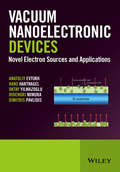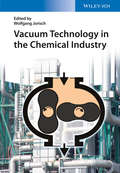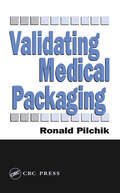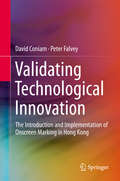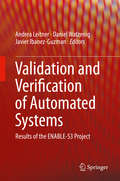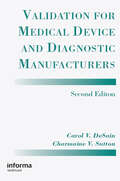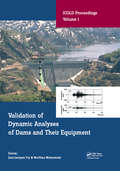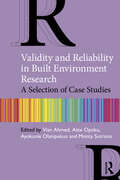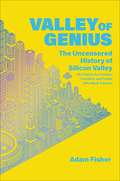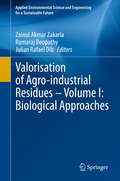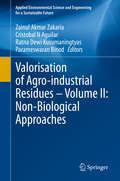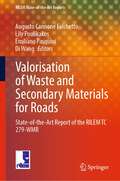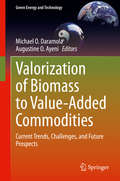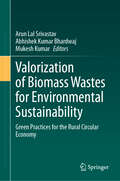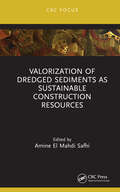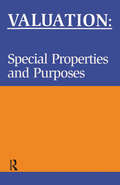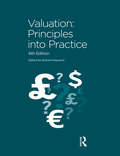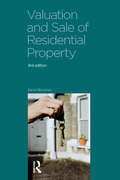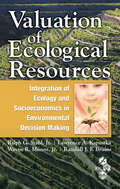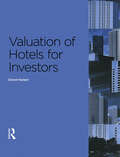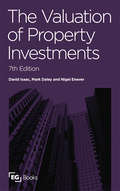- Table View
- List View
Vacuum Nanoelectronic Devices
by Hans Hartnagel Anatoliy Evtukh Dimitris Pavlidis Oktay Yilmazoglu Hidenori MimuraIntroducing up-to-date coverage of research in electron field emission from nanostructures, Vacuum Nanoelectronic Devices outlines the physics of quantum nanostructures, basic principles of electron field emission, and vacuum nanoelectronic devices operation, and offers as insight state-of-the-art and future researches and developments. This book also evaluates the results of research and development of novel quantum electron sources that will determine the future development of vacuum nanoelectronics. Further to this, the influence of quantum mechanical effects on high frequency vacuum nanoelectronic devices is also assessed. Key features: * In-depth description and analysis of the fundamentals of Quantum Electron effects in novel electron sources. * Comprehensive and up-to-date summary of the physics and technologies for THz sources for students of physical and engineering specialties and electronics engineers. * Unique coverage of quantum physical results for electron-field emission and novel electron sources with quantum effects, relevant for many applications such as electron microscopy, electron lithography, imaging and communication systems and signal processing. * New approaches for realization of electron sources with required and optimal parameters in electronic devices such as vacuum micro and nanoelectronics. This is an essential reference for researchers working in terahertz technology wanting to expand their knowledge of electron beam generation in vacuum and electron source quantum concepts. It is also valuable to advanced students in electronics engineering and physics who want to deepen their understanding of this topic. Ultimately, the progress of the quantum nanostructure theory and technology will promote the progress and development of electron sources as main part of vacuum macro-, micro- and nanoelectronics.
Vacuum Technique
by L.N. RozanovVacuum technology finds itself in many areas of industry and research. These include materials handling, packaging, gas sampling, filtration, degassing of oils and metals, thin-film coating, electron microscopy, particle acceleration, and impregnation of electrical components. It is vital to design systems that are appropriate to the application, a
Vacuum Technology in the Chemical Industry
by Wolfgang JorischBased on the very successful German edition and a seminar held by the German Engineers` Association (VDI) on a regular basis for years now, this English edition has been thoroughly updated and revised to reflect the latest developments. It supplies in particular the special aspects of vacuum technology, applied vacuum pump types and vacuum engineering in the chemical, pharmaceutical and process industry application-segments. The text includes chapters dedicated to latest European regulations for operating in hazardous zones with vacuum systems, methods for process pressure control and regulation and leak detection. All of the authors work or did work at a selection of the most important German companies involved in vacuum technology, and their expertise is disseminated here for engineers working in vacuum technology, chemical process design, plant operation, and mechanical engineering.
Validating Medical Packaging
by Ronald PilchikAccording to the FDA Quality System Regulations, manufacturers must ensure that "device packaging and shipping containers are designed and constructed to protect the device from alteration or damage during the customary conditions of processing, storage, handling, and distribution." As specific as this statement is, the FDA does not provide instruc
Validating Technological Innovation
by David Coniam Peter FalveyThis book discusses Hong Kong's use of onscreen marking (OSM) in public examinations. Given that Hong Kong leads the way in OSM innovation, this book has arisen from a recognised need to provide a comprehensive, coherent account of the findings of various separate but linked validation studies of onscreen public examinations in Hong Kong. The authors discuss their experience of the validation process, demonstrating how high-stakes innovation should be fully validated by a series of research studies in order to satisfy key stakeholders.
Validation and Verification of Automated Systems: Results of the ENABLE-S3 Project
by Andrea Leitner Daniel Watzenig Javier Ibanez-GuzmanThe book summarizes the main results of the the project ENABLE-S3 covering the following aspects: validation and verification technology bricks (collection and selection of test scenarios, test executions envionments incl. respective models, assessment of test results), evaluation of technology bricks in selected use cases and standardization and related initiatives. ENABLE-S3 is an industry-driven EU-project and aspires to substitute todays' cost-intensive verification and validation efforts by more advanced and efficient methods. In addition, the book includes articles about complementary international activities in order to highlight the global importance of the topic and to cover the wide range of aspects that needs to be covered at a global scale.
Validation for Medical Device and Diagnostic Manufacturers
by Carol V. Desain Charmaine V. SuttonImplementation of FDA's Design Control requirements (21 CFR 820.30) changed an entire industry. Quality System Requirements defined the approach to medical device validation. Product design, manufacturing process, and test method validation studies must be performed before or as a product is transferred to commercial production. Validation studies
Validation of Dynamic Analyses of Dams and Their Equipment: Edited Contributions to the International Symposium on the Qualification of Dynamic Analyses of Dams and their Equipments, 31 August-2 September 2016, Saint-Malo, France (ICOLD Proceedings)
by Jean-Jacques Fry Norihisa MatsumotoValidation of Dynamic Analyses of Dams and Their Equipment is the outcome of a three year cooperation program between CFBR (Comite Francais des Barrages et Reservoirs or French Committee on Large dams) and JCOLD (Japan Commission on Large Dams), and focusses on the dynamic behavior of concrete and embankment dams analyzed based on acceleration records of the JCOLD data base. The book covers a broad range of topics, including simplified and detailed methods of dynamic analysis for the seismic response of concrete and embankment dams compared with measured behavior. The response of embankment dams subjected to a 1.0 g foundation acceleration time history is computed by several analytical methods and compared. The modelling of stress-strain behavior of compacted soils for seismic stability analysis of earth-fill dams and its application for a failed earthfill dam is described. The cracking of the face slab of four faced rockfill dams during earthquakes is analyzed. The seismic behavior of concrete arch dams is discussed by the comparison of numerical and experimental results. Displacement-based seismic assessment of concrete dams is presented. Finally the book contains a comparison between the Japanese and French design criteria of gates and a comparison of the analysis of gates and field measurements. Validation of Dynamic Analyses of Dams and Their Equipment will be useful to professional and academics involved or interested in dam engineering.
Validity and Reliability in Built Environment Research: A Selection of Case Studies
by Vian AhmedThis book aims to guide researchers who are engaged in social science and built environment research through the process of testing the reliability and validity of their research outputs following the application of different methods of data collection. The book presents case studies that emphasize reliability and validity in different examples of qualitative, quantitative and mixed method data sets, as well as covering action research and grounded theory. The reader is guided through case studies that demonstrate: An understanding of the reliability and validity approaches from social science and built environment perspectives in alignment with the relevant research philosophies, approaches and data collection strategies Real research projects that have been conducted by expert researchers on topics such as Lean, BIM, Housing and Sustainability to answer specific or evolving questions in relation to the reliability and validity of research A simple and easy method that students at Masters and PhD levels can relate to in order to adopt a sound reliability and validity approach to their research This book is the essential guide for researchers at undergraduate and postgraduate level who need to understand how to validate the quality of the empirical tests they conduct using different techniques. The book will also be a great asset to supervisors from different backgrounds who need a refresher on this key aspect of the research cycle.
Valley of Genius: The Uncensored History of Silicon Valley (As Told by the Hackers, Founders, and Freaks Who Made It Boom)
by Adam Fisher"This is the most important book on Silicon Valley I've read in two decades. It will take us all back to our roots in the counterculture, and will remind us of the true nature of the innovation process, before we tried to tame it with slogans and buzzwords." -- Po Bronson, #1 New York Times bestselling author of The Nudist on the Late Shift and Nurtureshock A candid, colorful, and comprehensive oral history that reveals the secrets of Silicon Valley -- from the origins of Apple and Atari to the present day clashes of Google and Facebook, and all the start-ups and disruptions that happened along the way.Rarely has one economy asserted itself as swiftly--and as aggressively--as the entity we now know as Silicon Valley. Built with a seemingly permanent culture of reinvention, Silicon Valley does not fight change; it embraces it, and now powers the American economy and global innovation. So how did this omnipotent and ever-morphing place come to be? It was not by planning. It was, like many an empire before it, part luck, part timing, and part ambition. And part pure, unbridled genius...Drawing on over two hundred in-depth interviews, VALLEY OF GENIUS takes readers from the dawn of the personal computer and the internet, through the heyday of the web, up to the very moment when our current technological reality was invented. It interweaves accounts of invention and betrayal, overnight success and underground exploits, to tell the story of Silicon Valley like it has never been told before. Read it to discover the stories that Valley insiders tell each other: the tall tales that are all, improbably, true.
Valorisation of Agro-industrial Residues – Volume I: Biological Approaches (Applied Environmental Science and Engineering for a Sustainable Future)
by Zainul Akmar Zakaria Ramaraj Boopathy Julian Rafael DibAgriculture and industry are the two most important economic sectors for various countries around the globe, providing millions of jobs as well as being the main source of income for these countries. Nevertheless, with the increasing demand for agricultural and industrial produce, huge amounts of waste are also being produced. Without proper management, this waste (both liquid and solid) poses a serious threat to overall environmental quality, mainly due to its toxicity and slow degradation processes. Current approaches are effective but would normally require huge capital investments, are labour intensive and generate potential hazardous by-products. As such, there is a need for alternative approaches that are cheaper, easier-to-handle and have a minimum potential impact on environmental quality. This book presents up-to-date approaches using biological techniques to manage the abundance of waste generated from agricultural and industrial activities. It discusses techniques such as bioconversion, biodegradation, biotransformation, and biomonitoring as well as the utilization of these wastes. A number of chapters also include individual case studies to enhance readers’ understanding of the topics. This comprehensive book is a useful resource for anyone involved in agricultural and industrial waste management, green chemistry or biotechnology. It is also recommended as a reference work for graduate students and all agriculture and biotechnology libraries.
Valorisation of Agro-industrial Residues – Volume II: Non-Biological Approaches (Applied Environmental Science and Engineering for a Sustainable Future)
by Zainul Akmar Zakaria Cristobal N Aguilar Ratna Dewi Kusumaningtyas Parameswaran BinodThe world’s population is expected to reach the eight billion mark very soon. As a result, there is a need for increased industrial and agricultural production to ensure human wellbeing. This in turn generates huge amounts of waste. Current waste treatment solutions are effective, but usually require huge capital investment, are labour intensive and potentially lead to hazardous by-products. This book presents the latest non-biological approaches to address issues related to the abundance of waste, offering insights into best practices in various regions around the globe. It highlights techniques such as chemical extraction, pyrolysis and ultrasonics, and a number of chapters include individual case studies to further enhance readers’ understanding. This comprehensive reference resource is intended for graduate students, researchers and scientists, and is also a valuable addition to all agriculture and biotechnology libraries.
Valorisation of Waste and Secondary Materials for Roads: State-of-the-Art Report of the RILEM TC 279-WMR (RILEM State-of-the-Art Reports #38)
by Augusto Cannone Falchetto Lily Poulikakos Emiliano Pasquini Di WangThis book presents the work of the RILEM TC 279-WMR, whose purpose was to facilitate the use of waste, marginal and secondary materials for roads by investigating the performance of road materials containing waste through round robin tests and the development of standard procedures for their selection, preparation, and use. The structure of this book includes an introduction, five technical chapters, and a conclusion. The topics addressed are: the use of asphalt binder additives such as plastic and rubber; the combined use of aggregate and filler substitute in paving mixtures (construction demolition waste, rubber, and steel slags); the environmental assessment and the potential sources of pollutants originated from the use of this recycled materials.
Valorization of Agro-Industrial Byproducts: Sustainable Approaches for Industrial Transformation
by Anil Kumar Anal and Parmjit S. PanesarThis book covers sustainable approaches for industrial transformation pertaining to valorization of agro-industrial byproducts. Divided into four sections, it starts with information about the agro/food industry and its byproducts, including their characterization, followed by different green technologies (principle, process strategies and extraction of bioactive compounds) applied for the management of agro industry byproducts. It further explains biotechnological interventions involved in the value addition of these byproducts. Various regulatory and environmental concerns related to by-product management along with biorefinery concept and future strategies are provided as well. Features: Provides extensive coverage of agro-industrial by products and their environmental impact. Details production of value-added products from agro-industrial waste. Describes environmental legislations and future strategies. Presents multidisciplinary approaches from fundamental to applied and addresses the biorefinery and circular economy. Includes innovative approaches and future strategies for management of agro-industrial waste. This book is aimed at researchers, graduate students and professionals in food science/food engineering, bioprocessing/biofuels/bioproducts/biochemicals and agriculture, bioeconomy, food waste processing, post-harvest processing, and waste management.
Valorization of Biomass to Value-Added Commodities: Current Trends, Challenges, and Future Prospects (Green Energy and Technology)
by Michael O. Daramola Augustine O. AyeniThis book presents the most up-to-date technologies for the transformation of biomass into valuable fuels, chemicals, materials, and products. It provides comprehensive coverage of the characterization and fractionation of various types of biomass and details the many challenges that are currently encountered during this process. Divided into two sections, this book discusses timely topics such as the characterization of biomass feedstock, pretreatment and fractionation of biomass, and describes the process for conversion of biomass to value-added commodities. The authors bring biomass transformational strategies that are yet to be explored to the forefront, making this innovative book useful for graduate students and researchers in academia, government, and industry.
Valorization of Biomass Wastes for Environmental Sustainability: Green Practices for the Rural Circular Economy
by Mukesh Kumar Arun Lal Srivastav Abhishek Kumar BhardwajThis volume discusses the reduction, recycling, and reuse of industrial and agricultural biomass wastes to develop value-added products using environmentally sustainable practices and technologies. Through these waste valorization approaches, biomass waste materials can be converted into useful bio-chemical products, sustainable construction materials, polymers, bio-energy, and bio-fuel as sustainable alternatives to products and materials with negative environmental and health consequences. The chapters highlight the development and implementation of eco-friendly solutions to biomass waste production with the aim of reducing natural resource deterioration, bolstering rural and small-scale business systems in communities impacted by pollution and climate change, and providing power from residual biomass to broadly reduce environmental impacts through improved waste management practices. The book is intended to be a useful resource for researchers, policymakers, NGOs, government agencies, and local community authorities working in waste management and environmental sustainability.
Valorization of Dredged Sediments as Sustainable Construction Resources
by Amine El Mahdi SafhiValorization of Dredged Sediments as Sustainable Construction Resources provides a comprehensive and up-to-date overview of research on the reuse of sediments as a raw material for civil engineering fields. Dredging is increasing in scale worldwide, while deep sea disposal is being eliminated and landfill disposal is becoming less sustainable. Yet these sediments offer a potentially useful resource for constructing pavements, soil, bricks, ceramic and clinker, for they provide fine and lightweight aggregates, supplementary cementitious materials and geopolymer binders. This has sparked considerable research on valorization, which is presented here. Covers the main re-uses of sediments and the valorization required Focuses on state-of-the-art research on practical guidance Discusses limitations and future perspectives for sediments valorization The book suits researchers and students working in the area, as well as industrial engineers and professionals working on recycling and dredging.
Valorization of Food Processing By-Products (Fermented Foods and Beverages Series)
by M. ChandrasekaranBiotechnology has immense potential for resolving environmental problems and augmenting food production. Particularly, it offers solutions for converting solid wastes into value-added items. In food processing industries that generate voluminous by-products and wastes, valorization can help offset growing environmental problems and facilitate the s
Valorization of Wine Making By-Products
by Matteo BordigaAn overview of wine making by-products and their conventional and non-conventional uses, Valorization of Wine Making By-Products gives you a deeper understanding of recovery processes that are a part of the new philosophy of sustainable agriculture. In line with the worldwide movement toward sustainable development, this book examines how to conver
Valuation: Special Properties And Purposes
by Phil Askham Leslie BlakeEach topic treated represents an area of specialism in its own right. This book helps fill the gap between the extremes of neglect and detailed consideration in existing texts by providing an authoritative and yet accessible treatment of several complex and technical subjects. Each chapter has been written by an acknowledged expert in the field with extensive practical experience, and where appropriate is supported by comprehensive case studies and worked examples. What this book emphatically will not do, is turn anyone into an expert in the specialist and even arcane worlds of the plant and machinery valuer or the valuation of milk quotas. What it will do, however, is give some indication of the problems and pitfalls associated with these fields.
Valuation: Principles into Practice
by R. E. H. HaywardThe sixth edition of Valuation: Principles into Practice continues to be both a core text for all students undertaking surveying qualifications and a handy reference guide for valuers in practice. The new edition has been thoroughly updated with nine completely re-written chapters. The book provides extensive details of valuation principles and practices in agricultural, commercial, residential, industrial and leisure sectors. The balance of academic and practicing contributors explore the law and regulation within the field of valuation and include chapters on valuations for financial investments, taxation and rating insurance, as well as useful case studies and detailed approaches to valuation procedures for a variety of properties from farms to public houses. With extensive market knowledge and the obvious benefit of his involvement with the five previous editions, Richard Hayward brings the sixth edition well into the twenty-first century. The book continues it’s tried and tested melding of ‘town and gown’, and the twenty six contributors to the twenty three chapters are all leading specialists in their fields.
Valuation and Sale of Residential Property
by David MackminValuation and Sale of Residential Property is aimed at all those studying for a qualification or already practising as residential valuers, surveyors and estate agents. It provides valuable information on all elements of the home sales process, enabling professionals to give advice on market value, the best means for sale, condition and financial arrangements. Topics covered include: determinants of value and provision of the valuation agency, auction and taking instructions mortgage valuation and survey legal process and types of tenure investment and return. The author considers these topics against a background of wide legislative change and draws on the standard guidelines set down by the RICS and NAEA. This third edition, written at a time of rapid change in the home-selling market, details the processes and procedures for dealing with this ever-evolving market. Whatever your level of seniority, this book will help you stay ahead of the game and present sound advice to clients at any stage of the process.
Valuation of Ecological Resources: Integration of Ecology and Socioeconomics in Environmental Decision Making
by Ralph G. Stahl Jr. Lawrence A. Kapustka Wayne R. Munns Jr. Randall J. BruinsChoosing the optimal management option requires environmental risk managers and decision makers to evaluate diverse, and not always congruent, needs and interests of multiple stakeholders. Understanding the trade-offs of different options as well as their legal, economic, scientific, and technological implications is critical to performing accurate
Valuation of Hotels for Investors
by David HarperThis book provides detailed, up-to-date knowledge that will help property professionals become successful in the hotel market. The book includes a range of valuation practices and shows the reader the most effective way to read, manage and work their way through this highly competitive market. The author focuses on current methodology and practice within the hotel market, the market trends and legalities which will change or amplify those practices, and further sets out property investment options with real examples.
The Valuation of Property Investments
by David Isaac Mark Daley Nigel EneverThe credit crunch has highlighted the fact that fully understanding property appraisal and valuation is more critical than ever. With a long and reliable history, this new seventh edition covers all the major aspects of valuing various types of investment property. Fully updated and revised, this edition tackles the problems of inflation and growth, the equated rent principle and the special problems of short leaseholds, reversionary investments and taxation implications. Separate sections are devoted to investment appraisal, risk, investment strategy and computer and statistical aids.
